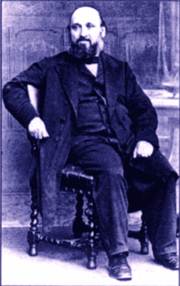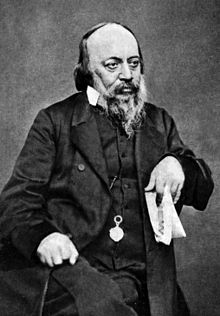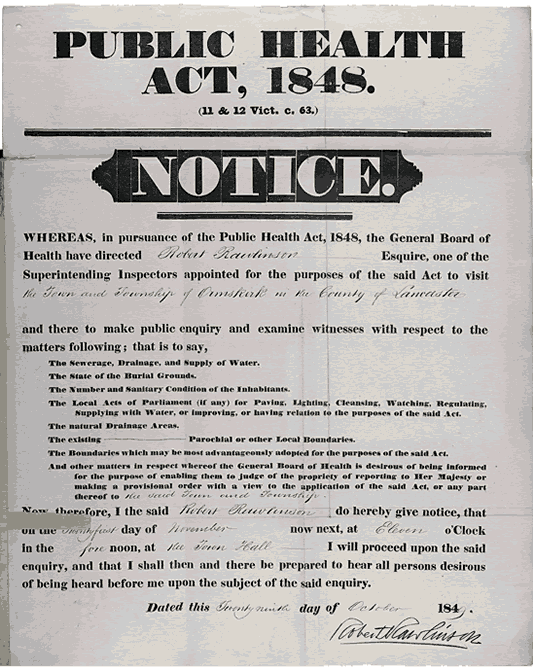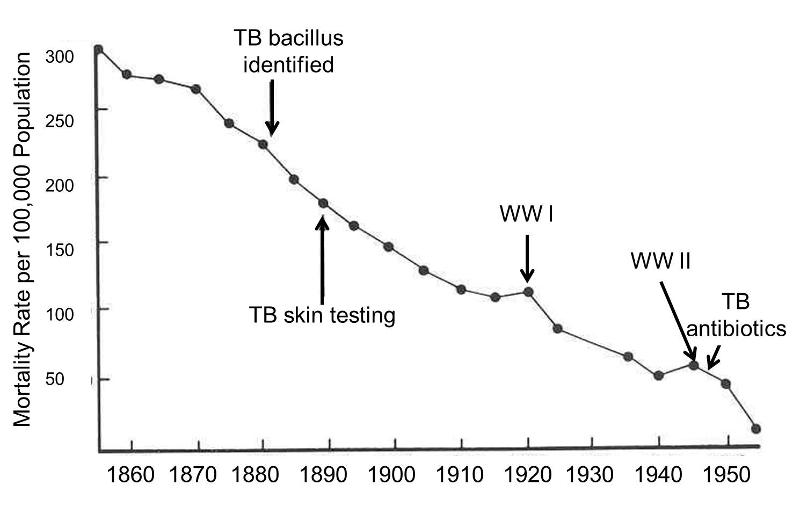The Sanitary Idea (1850-1875)
In many respects, public health as we think of it today (i.e., as a function of good government) took shape in London and Paris in the wake of the devastating health consequences of the Industrial Revolution. However, the circumstances that propelled the development of public health as a discipline are more complex with many contributing factors. First, there was the notion of the importance of the monarchy and the power of the state. The influence and power of the state could be assessed in many ways including commerce and trade, but also by the size of the population and the health and fitness of the working population.
This crude notion made the work of John Graunt quite compelling, and the importance attached to "numbering the people" grew. Not surprisingly, the General Registrar's Office was established in 1837 to record compulsory registration of births, deaths, and marriages in England and Wales. Dr. William Farr (below) was appointed Chief Statistician; Farr had trained at the Royal Academy of Medicine in Paris. The General Registrar's Office established the importance of surveillance with respect to health.

A second factor was the emergence of the Enlightenment in the 18th century, which embraced democracy, citizenship, reason, rationality, and the social value of intelligence (the value of information gathering). These ideas provided important underpinnings for public health. In the early 1800s, Jeremy Bentham and his disciples (the theoretical radicals) developed the philosophy of utilitarianism which provided a theoretic underpinning for health policy and wider social policies. One theme was that the reduction of mortality and improvements in health had an economic value to society. Healthy workers were more able to contribute to the economy of the state. Implicit in utilitarianism was the notion that one could measure 'evil' by the degree of misery that was created (or relieved) by a particular action. To Bentham the welfare of both the wealthy and the poor could be achieved most efficiently with good government.
Link to more on Utilitarianism
Yet another factor was the recognition that poor health was a burden that fell disproportionately on the poor. Villerme, a physician in Paris, had noticed that mortality rates varied widely among the districts (arrondissement) of Paris. He tried to correlate mortality with the distance of the arrondissement from the Seine River, the relationship of the streets to the prevailing winds, the arrondissement's source of water and local climatological factors such as soil type, exposure to the sun, elevation and inclination of the arrondissement. None of these things correlated. However, when he used tax rates as an indicator of wealth, Villerme found a striking correlation with mortality rates.
The graph below shows the correlation between poverty and mortality rates among different districts (arrondissements) in Paris found by Villerme. There is obviously a striking linear relationship between the degree of poverty in the districts and their mortality rates. This relationship has persisted for centuries, and it is a powerful predictor of health.
In 1842 Sir Edwin Chadwick, a social reformer, published a report entitled the 'Report into the Sanitary Conditions of the Labouring Population of Great Britain' proving that life expectancy was much lower in towns than in the countryside.

The report was extraordinarily innovative in that it drew a clear distinction between treatment and prevention. Chadwick argued that it was possible for the government to improve people's lives through reform; he believed that a healthier population would be able to work harder and would cost less to support. He concluded that what was really needed was not more physicians, but civil engineers to provide drainage of streets and to devise more efficient ways of delivering clean water and removing sewage and other noxious substances. These social, economic, political, and philosophical developments all contributed to the emerging idea that the public's health was a legitimate interest of government.
It is interesting to note that many of the proponents of the "Sanitary Idea," including Edwin Chadwick (shown on the right), were "miasmatists" who clung to the belief that disease was caused by breathing foul vapors. Since sewage and garbage smelled bad, they were associated with disease, so the miasmatists pushed to clean up the environment. And despite the fact that their belief in miasmas would prove to be incorrect, the end result was that many of the sources of infectious disease were removed. Chadwick was instrumental in creating a central public health administration that paved the way for drainage, sewers, garbage disposal, regulation of housing, and regulations regarding nuisances and offensive trades. This "sanitary idea" resulted in remarkable improvements in health and well-being, as illustrated in the graph below, which shows a remarkable decline in mortality from tuberculosis from the mid-19th century until the mid-20th century.
Chadwick's report provided momentum for the establishment of a number of societies and pressure groups consisting of politicians, civil servants, & social reformers lobbied parliament. Among others, these included:
- The Health of Towns Association, 1844
- The Metropolitan Association for Improving the Dwellings of the Industrial Classes
- The Association for Improving Cleanliness Among the Poor, and others.
Through their efforts landmark legislation was passed including:
- 1846 The Nuisances Removal Act was passed, giving local justices the power to prosecute and fine landlords for infractions having to do with sanitation (poor housing, garbage, cesspools and faulty drains).
- 1848 The Public Health Act created a General Board of Health in London that could direct localities to create local boards empowered to deal with environmental filth.

- In the 1850s The Epidemiologic Society of London was formed, consisting of local physicians, ex-military commanders, and civil servants who presented papers related to public health issues.
- 1853: John Snow presented "The comparative mortality of large towns and rural districts and the causes by which it is influenced". This intersection of statistics, philosophy, and economy sparked a new agenda for social reform.
These efforts had an enormous impact. The graph below shows the remarkable decline in mortality from tuberculosis in the United Kingdom from 1850 to 1960.The remarkable decline in mortality from TB and other infectious diseases is believed to have been the result of the many environmental improvements that occurred as a result of the implementation of the "Sanitary Idea." Note the temporary up-surge in TB death rates during the World Wars I & II, when nutrition suffered and many were forced to live in cramped, poorly ventilated quarters.
Louis Pasteur (late 1800)
Louis Pasteur was a French biologist and chemist who made enormous contributions to germ theory, to prevention of food spoilage, and to the control of disease. In 1853 Pasteur began studying fermentation in wine and beer and rapidly concluded that microorganisms were responsible. He also discovered that microbes in milk could be killed by heating to about 130 degrees Fahrenheit, a process which is now known as 'pasteurization'. He discovered that some microorganisms require oxygen (aerobic organisms), while others reproduce in the absence of oxygen (anaerobic).
Pasteur pioneered the idea of artificially generating weakened microorganisms as vaccines. Edward Jenner's work had demonstrated the principle with the naturally occurring cowpox, which could be used to vaccinate against smallpox. Pasteur was able to artificially weaken strains of anthrax and cholera in order to generate vaccines. It was, in fact, Pasteur who coined the term 'vaccine' in honor of Jenner's discovery. Pasteur developed vaccines against anthrax in sheep and cholera in chickens. In 1885 he developed a vaccine for rabies by growing it in rabbits and then drying the nerve tissue that had been infected with the virus. This vaccine was successfully used to save the life of a boy who had been bitten by a rabid dog.
|
|
As an example, consider the remarkable decline in mortality from tuberculosis that occurred in Great Britain from 1850 to 1960 as a result of the implementation of the "Sanitary Idea." The decline is shown in the graph below, but note the temporary increases in TB mortality that occurred during World War I and World War II when nutrition declined and people were periodically forced into air raid shelters, cramped living quarters, troop transports, and barracks..

Other infectious diseases showed similar declines.



